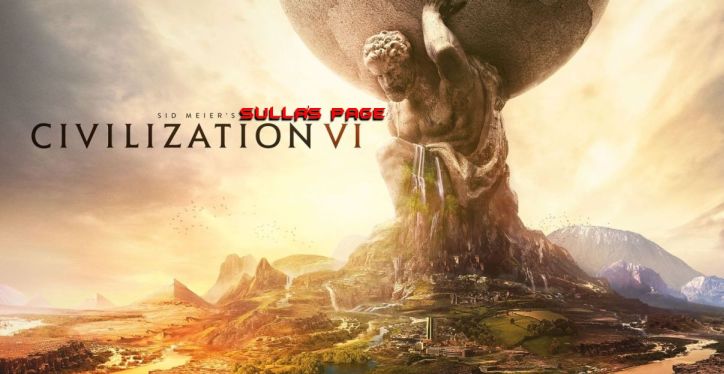


This is the short summary of a game that I played out on Livestream featuring Mansa Musa. This was the first Civ6 game that I played under the Gathering Storm expansion, and in fact the first Civ6 game to be played under either expansion since I never did anything with the previous Rise and Fall release. Overall I think that the expansions are a mixed bag, with some nice additions combined with a lot (and I mean a *LOT*) of unneeded feature bloat. The best addition in the expansions are the governors, which are a little bit micro-heavy but do add some interesting additional decisions in terms of choosing their promotions and moving them around from city to city (at least now that they've fixed the brokenly-overpowered Magnus from Rise and Fall). I also appreciate some of the balance tweaks that the designers have made over the course of half a dozen more patches, especially finally updating the policy cards so that discovering Feudalism civic no longer removes the ability to train Ancient era melee units with the +50% production card. There's also a new interface option that shows the military power / science / culture of all civs in the game at the top of the screen, and that alone is probably worth the cost of the expansions. The addition of era score with its Golden Ages and Dark Ages is pretty gimmicky, and I think that Golden Ages could have been implemented in a much better fashion. Most of the other stuff from the expansions is needless fluff, bloating out the gameplay with natural disasters and more lategame governments and rock bands and whatever. The only actively bad addition is the loyalty mechanic, which I would rip out of the game completely if I could.
While I don't intend to spend too much more time with Civ6, it was definitely worthwhile to do at least one game on Livestream as part of our Civ Fridays series to demonstrate the gameplay and explore some of these changes from the expansions. I chose Mansa Musa as my leader, both because he had some interesting gameplay changes to the standard Civ6 setup and because Mansa is a longtime fan favorite from the Civ4 AI Survivor series. With no Slavery civic present, production has always been king in Civ6, and yet Mansa as a leader changes this up in an unusual way. Mansa Musa gets +4 gold from every mine but no extra production at all, at least not until discovering Apprenticeship and Industrialization techs, along with a crippling penalty of -30% production to units and buildings. His Malinese civ also gets a unique Commercial district named the Suguba, which comes at half cost like all unique districts and gets an adjacency bonus from being placed next to Holy Site districts. Sugubas also can purchase Commercial district buildings using faith, and Malinese cities get +1 food and +1 faith for each desert tile next to the city center. The net effect of this is that Mansa is terrible at straight-up building things but compensates with huge amounts of gold income and (potentially) faith income. It leads to a noticeably different way of playing the game that focuses on maximizing gold income followed by cash-rushing or faith-rushing things to completion. This looked far more interesting than any of the other new Civ6 leaders and I decided to test out Mansa in this Livestream game.
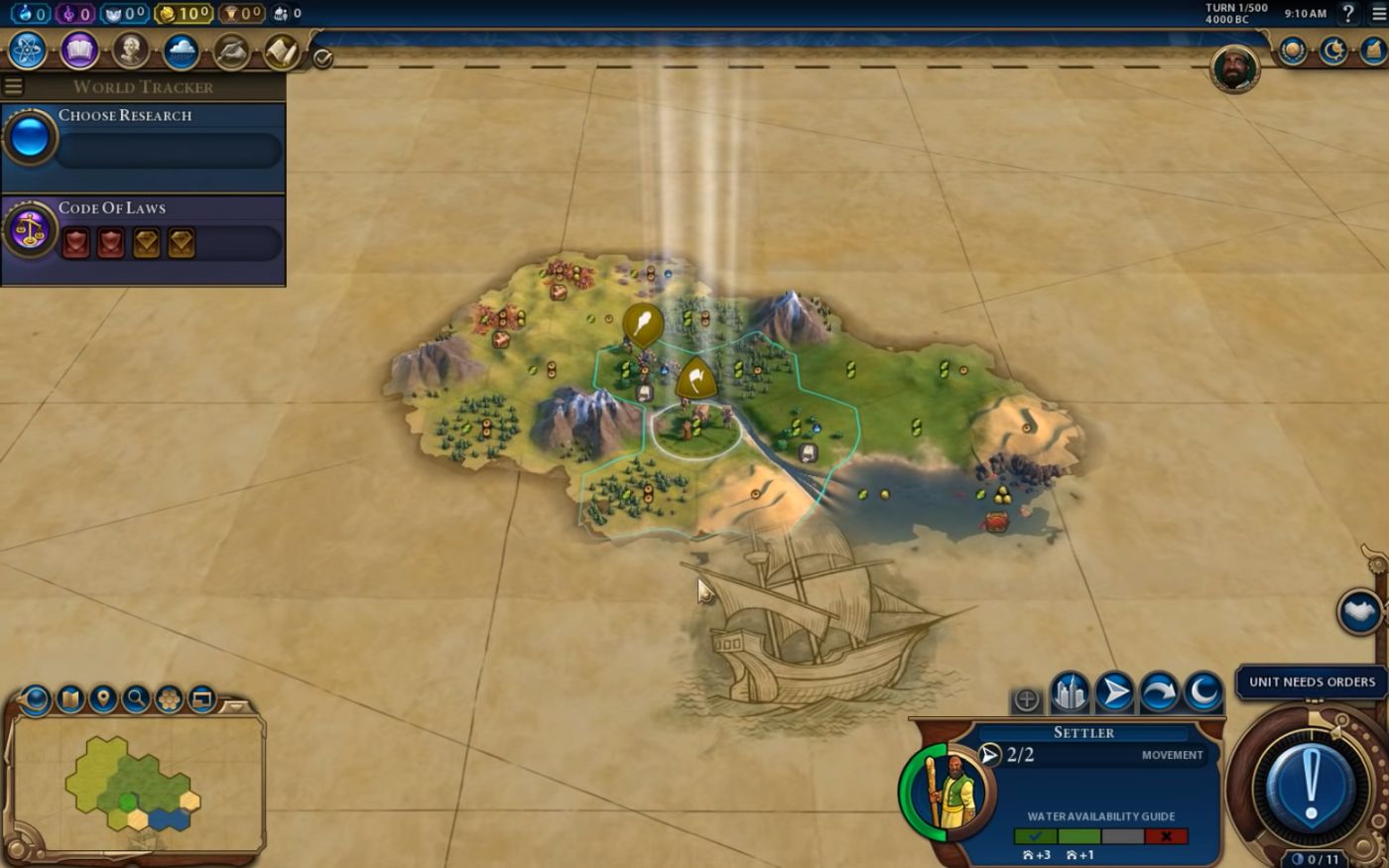
I rolled a starting save and took the first one that appeared. Unfortunately everything possible seemed to go wrong with this initial start. I spawned a barbarian camp nearby to the west, and although I used the initial starting warrior to clear it, another barbarian camp showed up on the other side of the capital. It was completely impossible to stop that second camp's scout from returning home and triggering a barb eruption, leading to eight total units (!) popping out of that camp in the first 40 turns of the game. This is one thing that I greatly dislike about Civ6, the extreme randomness of the barbarians. Some games they barely show up at all, and in some games there's nothing the player can do to stop them from sending unit after unit. At least this barb camp wasn't near any horse resources. My capital had spawned near the top of the map just south of the tundra, and there was virtually no land worth settling at all in the nearby vicinity. Expansion to the east was out because there were so many barbarians running around over there, the north had only tundra and the south held a large body of water. The only possible direction to travel was to the west.
This was where I had the bad luck to run into the worst feature added in the expansions: the loyalty mechanic. "Loyalty" is apparently supposed to simulate something like the culture flipping from past Civilization games, causing cities that are settled near other empires to suffer from a lack of loyalty and become "free cities", then eventually join another empire entirely. While this might sound good on paper, in practice it means that settling can only take place in strictly linear fashion, establishing new cities near previously existing cities to make sure that they stay loyal. If the player tries to settle an infamous "Pink Dot" city, it will only flip away from them due to a lack of loyalty. This is inherently bad for the gameplay, as conflict between rival empires for land is a good thing and making it impossible to settle near someone else leads to dull, formulaic gameplay. If an empire settles a city far away from the rest of their territory, the proper response is not some nebulous mechanic that forces a culture flip, it's to attack them and capture that exposed city! And if the aggressive settler can defend their claim, then they have proven that this territory does, in fact, belong to them. The loyalty mechanic in Civ6 is nowhere near as well designed as culture flipping was in Civ4, and I would argue that culture flipping wasn't even terribly well thought out in that game.

So I couldn't settle close to my capital in this initial world due to poor terrain and overwhelming barbarians, and the one place where I could settle was essentially outlawed due to the loyalty mechanic. There was a Khmer empire over in the west and their cities were pumping out too much "loyalty" for me to settle near them. The last straw came when I walked a settler for a dozen turns through the mountains, finally about to place my fourth city in one of the last remaining spots that wouldn't carry too much of a loyalty penalty, only for the Khmer to settle a city five tiles away and instantly make it impossible to my own city to be established. Too much of a loyalty penalty. This wasn't even remotely fair and it wasn't the game that I had envisioned played, so with the blessings of the Livestream chat I abandoned it and rolled a new game. I think that I might have been able to play that initial start into an eventual victory, but it wouldn't have been much fun.
The second start was infinitely more playable and served as the basis for a highly entertaining game. The capital itself had pretty weak terrain this time, but I was able to get a strong second city to the southeast which would eventually overshadow it. The early turns were very slow from a development perspective, as I hadn't been able to get the Mali gold economy up and running yet while that nasty -30% production penalty was affecting each unit build. Mali is a slow choice out of the gate in Civ6, much like the Financial/Organized combo of Darius in Civ4. The first 100 turns of this game were honestly a bit sad since Mali struggles so much to get established through those various penalties. I took the Religious Settlements pantheon to help out with this, which has inexplicably been boosted in Gathering Storm to award a free settler in the capital along with retaining its prior +15% faster cultural border expansions aspect. I have no idea why the designers added the free settler, which has made Religious Settlements obviously overpowered and ensured that it now has permanent ban status in our Multiplayer games. Here in Single Player though, it was a great choice to help the slow starting Mali get an additional city at an early date. (Be aware that this settler does increase the cost of the next settler so it's not totally "free" in that respect.)

It turned out that the only AI leader even remotely close was Seondeok of Korea, who was situated past the Commercial city state of Cahokia to the southwest. Korea's specialty is science with their own unique Campus district, and Seondeok ended up torching all of the other AI leaders in that respect, outputting roughly 3-4 times more beakers/turn than any of the other AI leaders. It was like Seondeok was playing a completely different game from the other AIs in terms of economic development. I befriended her and we never had any conflicts throughout the whole game, which was fine with me. I ended up having great relations with everyone else too, with the partial exception of Alexander of Macedonia who was only lukewarm. None of the other AIs were ever close enough to have a significant effect on the game, and this ended up being a peacefest from start to finish.
That left me to develop freely without worrying about attack or needing to invest much in terms of building units, only training enough of them to unlock the requisite tech and civic boosts along the way. Obviously this was a dream scenario for Mali, whose unit production malus is an otherwise crippline weakness. Instead, I diligently worked on building as many of the unique Suguba districts as possible and then faith-purchasing markets at each one to unlock the associated trade routes. This is a change from the non-expansion Civ6 gameplay, as the trade routes and the city state bonuses are now tied to the tier 1 buildings (markets, libraries, amphitheatres, etc.) instead of the districts themselves. I'm OK with this change as the non-expansion gameplay emphasized the districts themselves as opposed to the buildings inside them a little bit too much. There are also a whole ton of additional new wonders in the expansions, but the main wonders that I built came from the base game: first the Pyramids, followed by Petra and then the Colosseum. I built Petra in my second city (named $_$ and pronounced "Dollar Signs") and when combined with Mansa's natural gold bonus I ended up with a spectacular result, desert hill mine tiles that were producing 2/3/7 yields by the end of the game. This was easily the best city that I've ever had in Civ6 and it was a total pleasure to develop it over the course of the game.

Arguably the biggest turning point in the game came when I was able to land a Golden Age for the Medieval era, after having a Normal Age for the Classical period. I had a tough choice between two excellent Golden Age dedications: Free Inquiry (additional +10% science from tech boosts, Commercial/Harbor districts provide beakers equal to their gold bonus) and Monumentality (+2 movement for builders, civilian units purchasable with faith, settlers/builders 30% cheaper to purchase). I spent several minutes thinking about this decision and I think that the Livestream chat was leaning towards Free Inquiry since we were all keeping an eye on that huge science output of Korea. However, I thought that it would make more sense to play the longer game and push expansion using Monumentality, with the 30% cheaper purchase price for settlers/builders having tremendous synergy with Mansa's abilities. This ended up being the best decision of the entire game, as I would never train a single settler for the rest of the game via natural production, instead purchasing settler after settler after settler with gold. Another property of Mali's unique Suguba district is that all purchases in that city are 20% cheaper once the district completes, and therefore by stacking Monumentality together with the Suguba, I was getting settlers and builders for effective half price. That certainly beat training them at Mali's -30% production penalty! Add in the free builder that I was getting at each new city thanks to constructing the Ancestral Hall, plus having the Pyramids and Serfdom policy in place for 6 charge builders, and the effects were just disgusting.
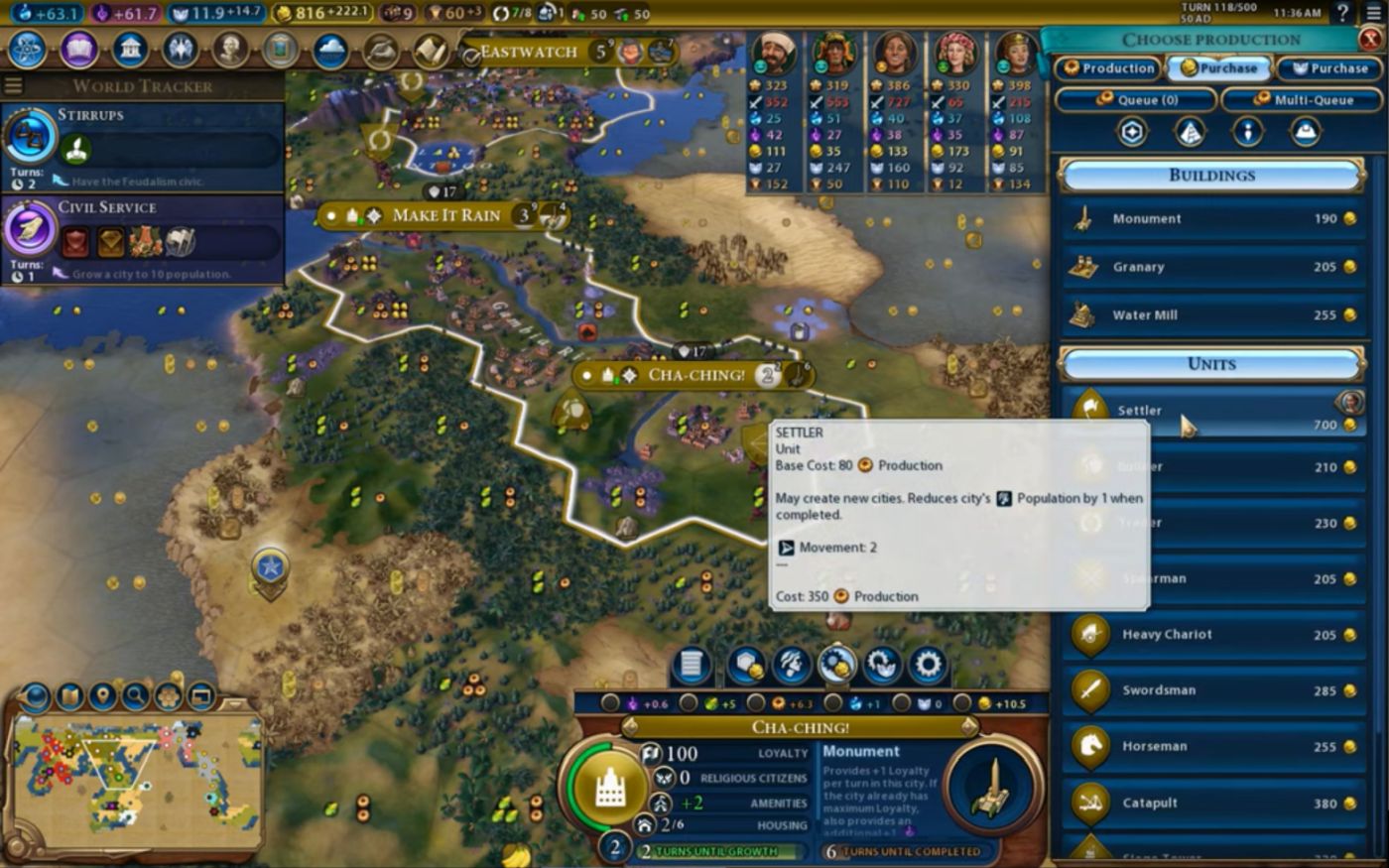
Over the course of several dozen turns, the Malinese empire ballooned in size with city after city going up across the continent. Every city came with its own new builder, who would immediately start improving resources and chopping forests/jungle to complete a cheap Suguba district as soon as possible. Monumentality even gave all of those builders 4 movement points, letting them move into forests and chop on the same turn much like the Indian Fast Workers can do in Civ4. I would send a trader to the new cities to help them get started, each one running a trade route back to $_$ for some kind of digusting yield, typically something like 4 food / 3 production / 3 gold / 1 beaker. As soon as the new city chopped out its Suguba, I would cash-rush or faith-rush a market inside, unlocking another trader to let the cycle continue onwards. The AI civs failed to keep pace with my expansion, several of them getting bogged down in pointless wars that never went anywhere because the Civ6 AI can't capture cities effectively, and the net result was that I blew past everyone in short order. Even the runaway AI of Korea was eventually left in the dust. I had close to 20 cities with an absurd gold/turn income without firing a shot in anger and they simply couldn't keep pace.
This game could have theoretically gone into any of the victory conditions except Religious (since I had made no attempt to establish a religion given the AI's obsession with it), and it might have been amusing to use Mansa's deep pockets to win the new Diplomatic victory by purchasing up all of the diplomatic favor from the other leaders. That would have required more turns slogging along through additional World Congress meetings though, and it wouldn't have been terribly interesting. My plan instead had been to shoot for a Cultural victory all along, and I planned for this by working towards the two key wonders for lategame tourism: the Eiffel Tower and Cristo Redentor. As I detailed in my American Tourist Paradise game, Eiffel Tower increases the appeal of all tiles by two, thereby unlocking far more tiles for seaside resorts and increasing the tourism output of already-qualifying seaside resorts. Cristo Redentor doubles the tourism output of all seaside resorts, and the combination of these two wonders can increase your tourism output in a hurry. The actual Great Works produced by Great Writers/Artists/Musicians play only a minor role in winning a tourism victory, which is probably not what the designers intended but is in fact how the gameplay works. I built a lot of Theatre Districts (typically the third district in many cities) and used them for Archaeological Museums, which offer much better tourism returns than Art Museums. Those things are just sad because it's way too difficult to get the theming bonus for the Great Artist works, while it's easy to get the theming bonus for the artifacts that the archaeologists dig up.
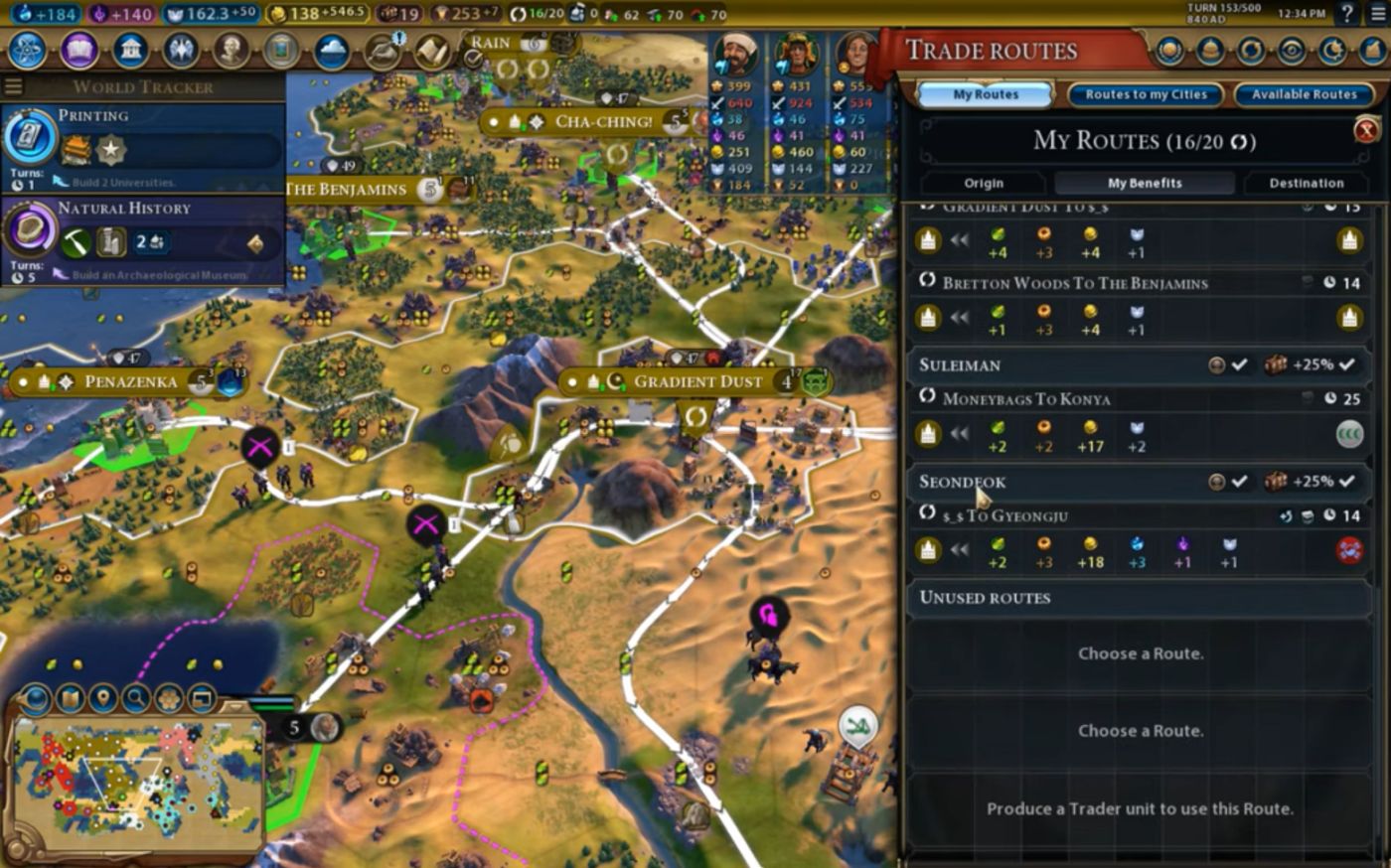
My capital built Eiffel Tower while $_$ used its massive production output to produce Cristo. They were helped along by a Great Engineer with wonder production charges, and I made sure to build the Mausoleum wonder to get a third Engineer charge in the process. After running Monumentality as my Golden Age dedication for 60 turns throughout both the Medieval and Renassiance eras, it was no longer an option for the Industrial era and I took the Heartbeat of Steam dedication instead. This granted a timely +10% production bonus towards Industrial era and later wonders along with Campus districts providing production equal to their science output. I also had the chance to experiment with the new "power" system for factories and some of the other lategame buildings, which looks like a nice addition to the game. With factories back up to providing 6 production to surrounding cities, it's finally worthwhile to construct a handful of Industrial districts again.

Anyway, I spent heavily to get a bunch of archaeologist units out on the map and digging up artifacts, then after finishing Eiffel and Cristo, I shifted my spending over to builders to get the resorts constructed. This basically turned into a minigame involving the tile appeal system, with builders removing mines (which lower appeal) and planting forests (which add appeal) to unlock more resort-eligible seaside tiles. Rainforests bizarrely lower the appeal of neighboring tiles, and therefore I had to cut down all of the jungles to construct more resorts, with Mansa Musa becoming a caricature of an evil corporate overlord. Gathering Storm has added a new type of resort called the Ski Resort, which can be constructed on any mountain tile as long as it's not adjacent to another ski resort, and provides a modest output of 2 tourism per turn. It looked bizarre to see a whole bunch of ski resorts popping up in the middle of the Malinese deserts, but hey, why not.  The expansion has also added "rock bands", units purchased with faith which travel to other civs and perform concerts that generate tourism. Everything about this system - archaeologists, resorts, rock bands - is an idiotic way to design a victory condition. The AI can't understand it at all and the whole system has little connection to your own cities. It's largely a bunch of minigames that the player is engaging in only tangentially connected to the rest of the empire-building gameplay. Why the designers never switched over to some kind of Civ4-esque "get three cities to X culture" goal is a mystery to me.
The expansion has also added "rock bands", units purchased with faith which travel to other civs and perform concerts that generate tourism. Everything about this system - archaeologists, resorts, rock bands - is an idiotic way to design a victory condition. The AI can't understand it at all and the whole system has little connection to your own cities. It's largely a bunch of minigames that the player is engaging in only tangentially connected to the rest of the empire-building gameplay. Why the designers never switched over to some kind of Civ4-esque "get three cities to X culture" goal is a mystery to me.
Lategame tourism ramps up very quickly once the resorts start going up with the proper modifiers in place. I had no tourism to speak of before building the Eiffel + Cristo combination, and within two dozen turns afterwards I was pulling in more than 1000 base tourism per turn. The designers have wisely toned down the biggest tourism beeline on the tech tree; in pre-expansion days, the Computers tech granted +100% to all sources of tourism and it could be researched while ignoring everything else in the Industrial and Modern eras. Here in Gathering Storm, that bonus has been toned down to +25% to tourism and a bunch of additional techs have to be researched before Computers can be pursued. This meant that it took slightly longer for tourism to hit critical mass, but only slightly longer. I had Open Borders with every leader and was running trade routes to them all, even reaching the end of the civics tree to put in the Online Communities policy for +50% tourism to civs with whom you have a trade route. By the end of the game I was picking up more than 10 foreign tourists per turn, and after an inexplicable delay of one turn for no clear reason, I achieved a victory at the end of Turn 219.
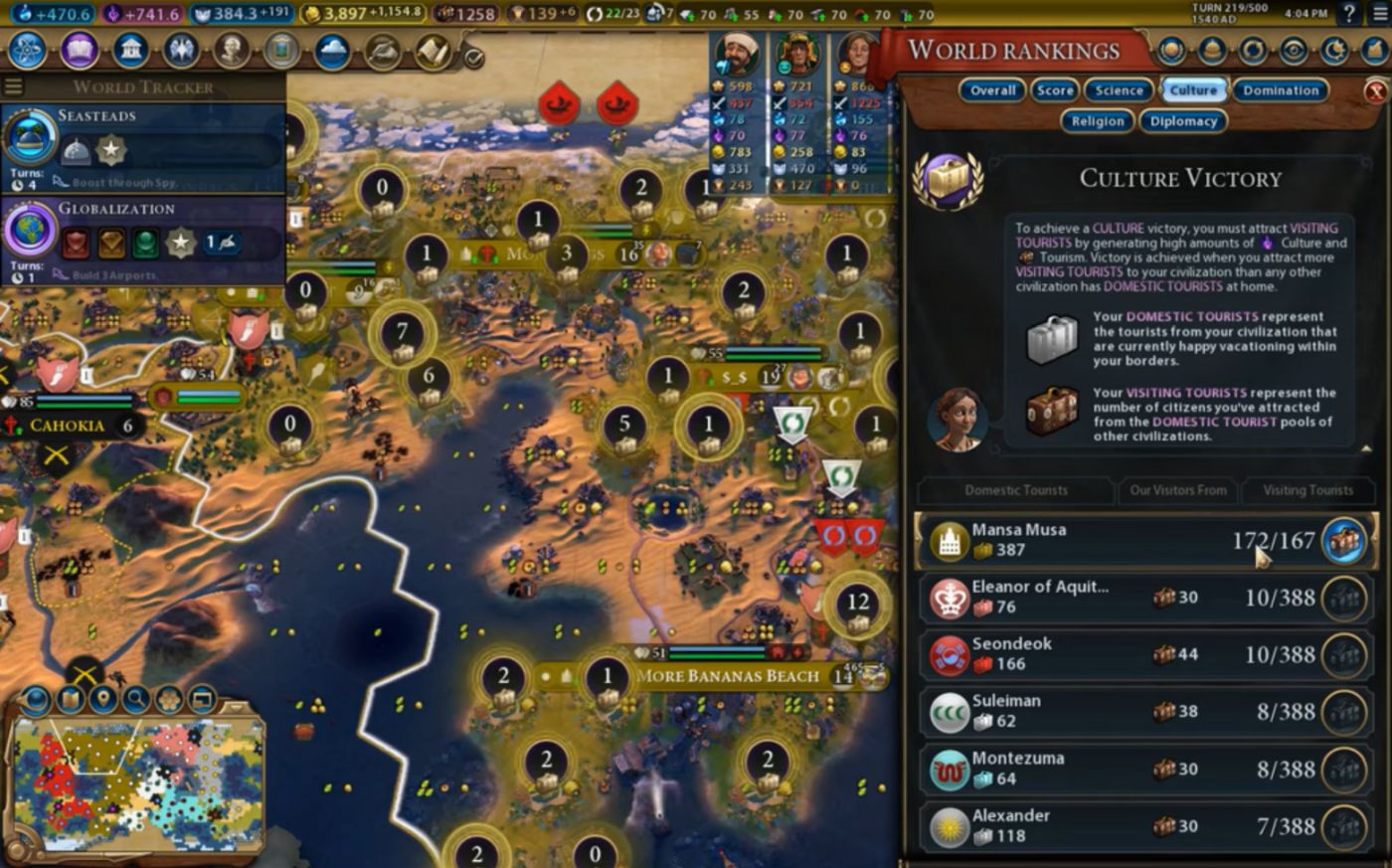
This was my fastest Cultural victory yet despite playing on a higher difficulty level (Immortal) and with the Computers tech tourism boost significantly nerfed compared to pre-expansion days. This was an entertaining game and it was particularly fun to try out Mali's unique take on the Civ6 gameplay. However, I don't anticipate spending much more time with Civ6 for the same reason that I articulated at the end of my No District Challenge game: the AI is still terrible. Due to the One Unit Per Tile rules, the AI can't threaten the player militarily outside of the Ancient Age cheese rush, and that removes most of the excitement from the gameplay. The AI also can't play the economic side of the game either, largely thanks to the complexity of the district placement rules. Maybe if all of the AIs were as strong as Korea in this game it would be one thing, but everyone other than Seondeok was hot garbage when it came to science or culture. After 200+ turns of an Immortal game, three of the four the non-Korean AI leaders were outputting less than 100 beakers/turn (Alex was at 155 beakers/turn). So they can't fight and they can't tech - it's pathetic. Civ6 as a game has solid mechanics and it all gets wasted because there's no AI to play the game against. 
Hopefully that's not too much of a downer to end this mini report. I had fun while playing and I think that the viewers did too. If we do another Civ6 game, I'll probably try something more combat-oriented for a change of pace. Thanks as always for watching and reading.



